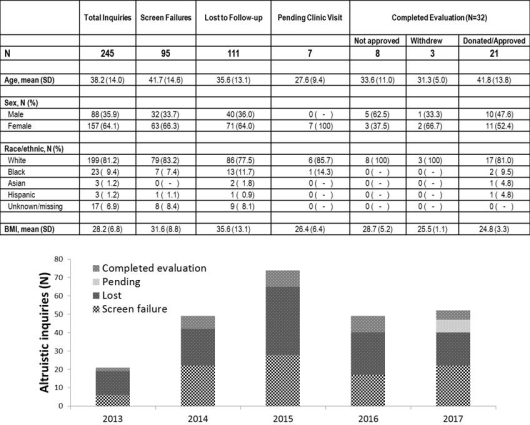The Altruistic Living Kidney Donor Phenotype – From Inquiry to Donation
V. Kumar, P. MacLennan, M. Bonventre, M. Hanaway, R. Reed, J. Locke.
University of Alabama at Birmingham, Birmingham.
Meeting: 2018 American Transplant Congress
Abstract number: 49
Session Information
Session Name: Concurrent Session: Kidney Living Donor: Selection
Session Type: Concurrent Session
Date: Sunday, June 3, 2018
Session Time: 2:30pm-4:00pm
 Presentation Time: 2:54pm-3:06pm
Presentation Time: 2:54pm-3:06pm
Location: Room 606/607
Background
We distinguish an altruistic donor from the traditional living donor when a living person's offer to donate an organ is to “anyone” and not attached to a specific individual recipient. Altruistic kidney donation from living donors is an uncommon but growing practice with paucity of data in the recent literature regarding trends in altruistic donation. We herein review our program's experience with the altruistic donor from inquiry to the final outcome of living kidney donation and transplantation.
Methods
We examined demographic characteristics of all altruistic donor inquiries from July 2013 to November 2017 and followed them longitudinally through our living kidney donor evaluation process recording end points of screen failures, lost to follow up, completed evaluation, not approved, withdrawals, approved to donate and finally donating a kidney.
Results
There were 245 altruistic donor inquires during this 4 year period with a 1.5 fold increase from 2014 to 2015 (Figure). Mean age at inquiry was 38 years and 64% were women, 81% self-identified as white race/ethnicity(Table). Thirty nine percent failed the initial screening process (n=95) while another 45% (n=111) were lost to follow up after passing the initial screen. Those lost to follow-up had the highest BMI (35.6kg/m2). Thirty two out of the original 245 or 13% completed the full donor evaluation and at last follow up 66% of these were approved and went on to donate. Altruistic donors who completed evaluation and donated had a mean age of 42 years, were more likely to be white (81%) and female (52%)(Table).
Conclusions
Evaluation of the potential altruistic donor is labor intensive with only 9% of donor inquires resulting into living kidney donation. Obesity appears to be a significant reason for the loss to follow up. However donors who pass the initial screen and remain highly motivated to undergo a full evaluation have a high conversion rate for approval and donation at 66%. It will be important to compare the conversion rate to non-altruistic donors to determine if specific policies for evaluating altruistic donors and identification of dedicated personal to follow this potential living organ donor pool are warranted.
CITATION INFORMATION: Kumar V., MacLennan P., Bonventre M., Hanaway M., Reed R., Locke J. The Altruistic Living Kidney Donor Phenotype – From Inquiry to Donation Am J Transplant. 2017;17 (suppl 3).
To cite this abstract in AMA style:
Kumar V, MacLennan P, Bonventre M, Hanaway M, Reed R, Locke J. The Altruistic Living Kidney Donor Phenotype – From Inquiry to Donation [abstract]. https://atcmeetingabstracts.com/abstract/the-altruistic-living-kidney-donor-phenotype-from-inquiry-to-donation/. Accessed December 29, 2025.« Back to 2018 American Transplant Congress

